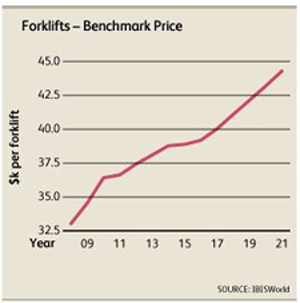Forklift prices, demand on the rise
During the past three years, forklift prices fell as a direct result of falling steel prices, which decreased production costs for suppliers.
 “In the three years to 2017, the price of steel declined due to an oversupply in China and weak demand from developed countries, limiting the extent of forklift price increases,” says Mark Seraydarian, IBISWorld Procurement Research analyst, “however, a return to growth in suppliers' input costs will drive accelerated price growth in the coming three years.”
“In the three years to 2017, the price of steel declined due to an oversupply in China and weak demand from developed countries, limiting the extent of forklift price increases,” says Mark Seraydarian, IBISWorld Procurement Research analyst, “however, a return to growth in suppliers' input costs will drive accelerated price growth in the coming three years.”
IBISWorld experts expect the price of steel to shift direction and rise at an average annual rate of 1.2 percent as supply and demand become more in sync. “As a result of increased input costs and rising demand, forklift prices are forecast to grow 2.6 percent during the same period,” continues Seraydarian.
In addition, the average price will increase as newer and more expensive technology becomes more commonly integrated into forklifts. “For example, while they already being used, fuel cells that add significantly to initial buying costs are expected to become increasingly popular power sources. Forklifts using such technology have the ability to be refueled quickly while emitting zero emissions. Although this improvement in fuel technology will benefit buyers by improving product diversity in the market, the resulting rise in prices will continue to erode buyer power.”
Interested in a more in-depth look at coming lift truck price trends? Contact www.ibisworld.com.
IBISWorld has research on several other equipment-related reports, including Tower Cranes, Front-End Loaders, Aerial Lift Rental and more.
Click here for the full list of IBISWorld Procurement Reports.









